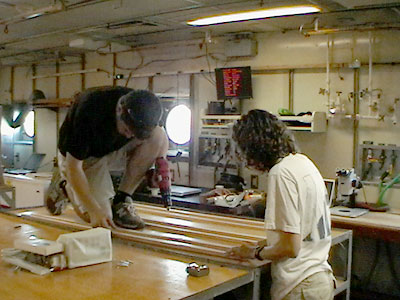

 | |||||||||
|
|
Journals 2008/2009Cheryl Manning
January 10, 2009 Setting up the core logging and description lab sites today was much like getting ready for classes to start in August. Rachel Scudder, Jeremiah O'Connor, Ashley Hatfield, Ben Vinhateiro, and I will be working together in two groups to curate and describe the core that we will be collecting. From each sampling site, we are collecting up to 85 meters of core. All of the core is collecting in PVC pipe that is 11.5 cm in diameter. There are three different ways we are doing this: Multicore (8 core of the top 0.5 m of seafloor sediment), Gravity Core (the top 5 m of sediment) and one or two 45m Long Core (also called piston core). The gravity and long core are cut into 1.5 m sections to make them more manageable. The curators, Ashley and Ben, are in charge of making sure that each section of every core is properly labeled for the site, sample, and depth. With help from Jeremiah, Rachel and I, the curators split each 1.5 m section of core lengthwise, exposing all the layers. Half of the core is archived, set aside for future analyses. The other half is brought to the sedimentology table for description.
"Describing the core" involves quick and accurate observations of color, grain size, chemistry, fossil content and anything else that we see. Joe Russell and Rachel attached strips of wood down to one of the tables today so that when the core is brought in, it doesn't roll around. I set up a microscope that will help us identify microfossils. We unloaded boxes of supplies and downloaded the forms that we will fill out for each 1.5 m section. Along with Ben and Ashley, we traced the route around the ship that the core will take. Jeremiah helped to put the multicore devise together. As it approaches 4:00 pm, I prepare to return to land for the last time until February 23 (we will see the Galapagos from a distance, no need to stop there now). I learned today that I will not be able to Skype with my family once we are onboard ship. Questions:
|
||||||||
